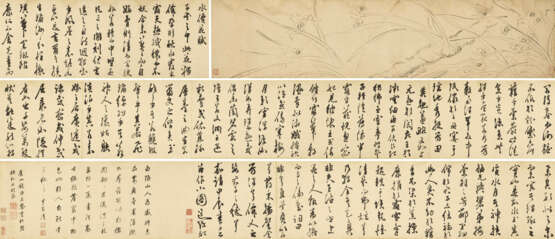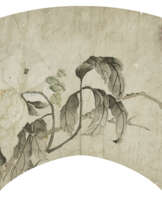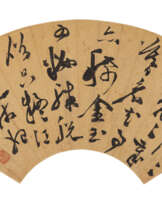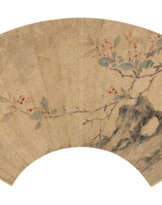ID 1086721
Lot 821 | CHEN CHUN (1483-1544)
Valeur estimée
HKD 8 000 000 – 12 000 000
Narcissus and Calligraphy
Handscroll, ink on paper
25 x 480 cm. (9 7⁄8 x 189 in.)
With one seal of the artist Followed by a poem, inscribed, signed and dated on a spring day, jiachen year of the Jiajing period (1544)
Colophons by: Dong Qichang (1555-1636), signed, with two seals Qian Qianyi (1582-1664), signed, with two seals Huang Junshi (b.1934), dated 2021, signed with four seals
Five collector’s seals: one of Qian Qianyi, two each of Yang Jin (1644-1728) and Liang Jingshi (1809-1859)
Literature
Xu Youzhen, “Poetry on Narcissus”, “Martial Art”, Siku Mingren Wenji, Shanghai Guji Publishing, Shanghai, December 1991, pp.19-20.
Zhu Liangzhi, “Discussion on the Fantasy of Chen Chun’s Paintings”, Rong Bao Zhai: Popular Art Monthly, Issue 8, Rong Bao Zhai, Beijing, August 2013, p.45.
Zhu Liangzhi, Sixteen Views on Chinese Literati Paintings, Beijing University Press, Beijing, September 2013, p.280.
Zhu Aidi, Chronology of Chen Chun, Shanghai Paintings and Calligraphy Publishing, Shanghai, December 2018, p.337.
Further details
The Pupil Who Surpassed His Masters: Mastery and Meaning in Chen Chun’s Narcissus and Calligraphy
Most students of Wen Zhengming (1470-1559) were confined to the shadow of the Ming Master in creating their poems, calligraphy and painting. Inheriting Wen’s techniques was an ultimate pursuit to them who adopted only the methodology but failed to extract and transcend the essence.
Chen Chun was an exception. In 1530, following his father’s order, the 20-year-old Chen began to study classism, literature, writing, calligraphy and painting under Wen. He also became a calligraphy student of Zhu Yunming, one of the Four Talents of Wu. Moreover, due to the strong relationship between his grandfather Chen Qiong (1440-1506) with the Wu School masters Shen Zhou (1427-1509), Wu Kuan (1435-1504) and Wang Ao (1450- 1524), Chen Chun unsurprisingly fostered a guided path with immediate access to the greatest art since an early age.
Wen Zhengming said, ‘I only teach Daofu (Chen Chun) literary studies for the civil examination. He crafted his own way in painting and calligraphy - not my disciple.’ Looking at Chen’s works today, regardless of the subject matter, brushwork and style, they all differ from Wen’s. Chen’s xieyi huaniao (free style depicting flowers and birds) genre seems to resemble Wen’s teacher, Shen Zhou; his calligraphy is more influenced by Zhu Yunming.
The chivalrous nature and dynamic talent of Chen were vividly revealed by this magnificent Narcissus and Calligraphy. Delineated in light ink of soft yet powerful double lines, the daffodils were executed by profuse brushworks; their movement concisely portrayed, as if they were tenderly dancing in the wind, echoing the subtle aesthetics from the Song dynasty. Wen commented Chen’s paintings as ‘original and witty’, which had coincided the notion of qiyun shengdong (spirit resonance) coined by Xie He in the Six Principles of Chinese paintings.
The poem on narcissus inscribed by Chen in cursive script conveyed a sense of depth and harmony, while retaining a precise balance from the playful asymmetry. Chen’s unrestrained mentality and refined technique were fully unleashed on this masterpiece which was executed in the later years of his career; it also perfectly assembled the distinguished calligraphic eminences of Wen and Zhu.
Narcissus and Calligraphy has a distinguished provenance. It was appraised and inscribed by Dong Qichang (1555-1636) and Qian Qianyi (1582-1664) in late Ming dynasty; collected and sealed by Yang Jin (1644-1728) in early Qing dynasty; acquired by Liang Jingshi (1809-1859) in late Qing dynasty. In modern days, Mr. Huang Junshi further appraised and inscribed the work with significant details of Chen Chun’s biography and artistic achievements, as well as the content of the painting and calligraphy.
Born with tremendous talents to a family of scholar-officials and having nurtured under the Wu masters, Chen’s profound artistry not only outshined his predecessors, but also earned a high merit under his art name Bai Yang in the history of Chinese painting.
| Artiste: | Chen Chun (1483-1544) |
|---|
| Artiste: | Chen Chun (1483-1544) |
|---|
| Adresse de l'enchère |
CHRISTIE'S 18 Chater Road Central Hong Kong Hong Kong | ||||||||||||||
|---|---|---|---|---|---|---|---|---|---|---|---|---|---|---|---|
| Aperçu |
| ||||||||||||||
| Téléphone | +85227601766 | ||||||||||||||
| Fax | +852 2760 1767 | ||||||||||||||
| Conditions d'utilisation | Conditions d'utilisation | ||||||||||||||
| Heures d'ouverture | Heures d'ouverture
|










